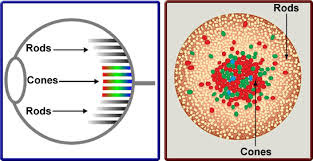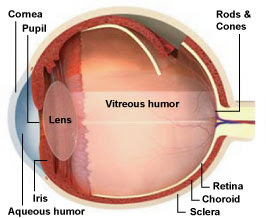in the array of sensory receptors added to the many creatures upon this earth, none is more fascinating to me than the eye. its job is to capture light waves (back to waves again…) and translate them into electrical signals that can be interpreted by the brain (or whatever thing a creature has for a brain), allowing creatures to observe and react to the world around them.
there is such a large variety and such a wide variance in the level of functionality in different creatures that i could go on for pages and pages about them. in lieu of that, i declare that May will be Eye Month on trivia wednesday! further, i intend to NOT include things related to eye trauma because that’s just not ok…
so, let’s begin at home with human eyes.
let’s talk about anatomy first. since eyes are designed to capture and interpret light waves, they need to be able to allow light into themselves, interpret that light, as well as control how much light comes in, so as to not destroy themselves.
light enters through the cornea and is controlled by the iris which expands and contracts to allow in various levels of light. in the middle of the iris is a hole, called the pupil, which is black because it doesn’t reflect any light. once it is allowed through the iris, light passes through the eye lens and on to the back of the eye where the retina sits, replete with rods and cones to translate light into electric signals which are carried by the optic nerve to the brain. thus, light enters the eye and our brains perceive colour, motion, shape, and distance.

the rods and cones are called those names because that is actually how they are shaped. they each do a different job for our vision. the rods are responsible for low-light vision and excel at perceiving motion and shape but they do not translate colour. the cones are active in high-light situations and perceive colour. since the immediate fovial point on the back of the eye (the first spot light hits when it reaches the retina) is populated exclusively by cones and the rods are scattered more to the sides, it makes sense, then, that we perceive motion better in our peripheral vision and why we are prone to turn our heads and eyes away from light sources when we’re trying to see in dark settings (at least, that’s why i do). further, we have twelve times more rods than cones so we generally actually see things in shades of grey with hints of colour.
interestingly, right where the optic nerve connects to the back of the eye, there are no photo receptors or light-sensitive membranes — this spot is called, not surprisingly, the blind spot. thus, the optic nerve connects not directly at the center of the back of the eye but slightly to the side so that light doesn’t need to constantly land on that spot as it comes in.
for regular human eyes, the minimum distance an object can be clearly focused is 25cm. for infants, however, that distance is 3-5cm since the important things for an infant are really close by like, for example, nipples. the maximum distance a regular eye can clearly focus is… wait for it… infinity! that’s right! there is no point at which the healthy, regular human eye can’t focus on a far away object. for example, consider the night sky — we don’t see a black mass or a massive white blur; we see individual points of light all over the place because our eyes can focus on the source of that light. that doesn’t mean, obviously, that we can see clear detail at such distances but only that we can see the light as a single source.

since we have two eyes on the front of our heads, we humans are good at spotting and tracking things which are moving ahead of us, like, for example, things we are hunting. if, however, something is coming directly toward us (like a ball or a straight punch) we tend to have trouble gauging the distance and speed and end up getting bopped in the nose because the cones aren’t doing so well at seeing things move. our two eyes pair together to help us focus accurately on stationary objects and objects in motion by moving in tandem and drawing together when focusing nearby (going cross-eyed).

human eyes fall under the category of complex eyes and are one of the most complex and widely capable eyes on the planet. we can easily perceive motion, complex shapes, large variations in distance, and an extremely broad range of colour. as we carry on throughout this month, we’ll look at different kinds of eyes which are used for the very different lives of the varied and wonderful creatures in this creation.
plus, eyes are pretty, with all their colourful and intense loveliness:
so far on human eyes











